Dan Pontefract's Blog, page 26
November 9, 2016
Trump Presidency Lesson Plan
Donald Trump won the American presidency. If you happen to be a K-12 teacher/educator, here’s a handy lesson plan you may want to consider. (you can download it as a PDF as well)
Trump Presidency Lesson Plan
1. Lesson Plan Information
Subject/Course: All of them
Grade Level: K-12
Topic: Trump Presidency
Length of Period: For as long as it takes
2. Expectation(s)
Expectation(s):
Brutal honesty. Don’t sugarcoat the situation. America is divided, broken. But it is the young citizens that are needed—more than ever—to push forward with a path to reconciliation. Our future depends on young people.
Learning Skills (Where applicable):
Compassion, honesty, respect, collaboration, empathy, creativity and love.
3. Content
What do I want the learners to know and/or be able to do?
Today learners will: appreciate democracy, break down divisions, create bridges and plan for a brighter, and better future where the word human is remembered as being an important/critical aspect of the word humanity.
4. Assessment (collect data) / Evaluation (interpret data)
(Recording Devices (where applicable): anecdotal record, checklist, rating scale, rubric)
Based on the application, how will I know students have learned what I intended?
All students agree better days lie ahead, but they also recognize it is up to them to create that future. Each student submits a one or two-line “personal purpose” statement that outlines how they are going to positively impact and change the state of America, as they shift from childhood to adulthood.
5. Learning Context
A. The Learners
(i) What prior experiences, knowledge and skills do the learners bring with them to this learning experience?
18-months of campaigning between Republican and Democratic primaries and general election hubris of 2015/2016.
(ii) How will I differentiate the instruction (content, process and/or product) to ensure the inclusion of all learners?
A sense of purpose, equality and respect knows no bounds. It is expected the teacher teaches to all skill levels and current understanding of the current situation in American politics and society in general.
B. Learning Environment
Open space, preferably in a circle to signify inclusion, togetherness and collaboration. (see Circle of Courage graphic below)
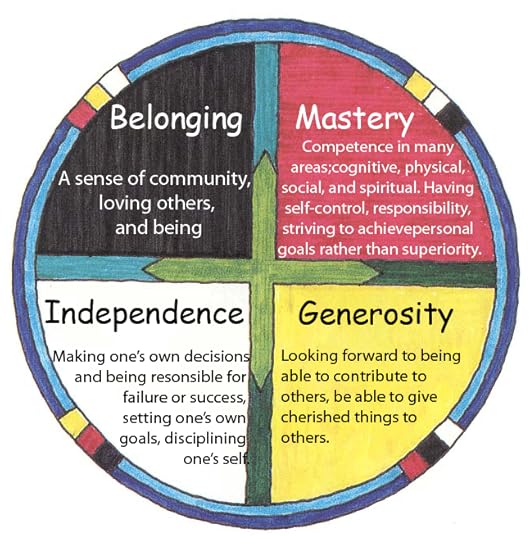
C. Resources/Materials
It is expected the teacher utilizes the Circle of Courage metaphor from First Nations. Arranging the class in an open-spaced circle (no desks), the teacher can then introduce the Circle of Courage as a metaphor of contemplation with respect to what society requires from each of us as human beings.
6. Teaching/Learning Strategies
INTRODUCTION
How will I engage the learners? (e.g., motivational strategy, hook, activation of learners’ prior knowledge, activities, procedures, compelling problem)
1) Show video highlights of 2016 Presidential debates. Then show acceptance speech of Donald Trump and consolation speech of Hillary Clinton.
2) Show exit polling data – differences between general population race and age brackets.
3) Ask open ended questions with the class. Begin a dialogue. Insert the Circle of Courage as an introductory metaphor.
MIDDLE:
Teaching: How does the lesson develop?
How we teach new concepts, processes (e.g., gradual release of responsibility – modeled, shared, and guided instruction).
1) Have students pair up with one another. Give them 5-10 minutes to define the attributes, behaviours and qualities they expect from each other as humans. Ask them to share with a group beside them.
2) Select several groups to share their results with the rest of the class.
3) Begin to explore the aspect of “purpose.” Engage the class in a discussion. What is purpose? What is your personal purpose? What is society’s purpose? How will purpose happen when you have to work? How can we ensure what you want and what society needs—in terms of purpose—is appropriate, measured and achieved?
4) Utilize “The Purpose Effect” model as a way to introduce this concept. (See graphic below)
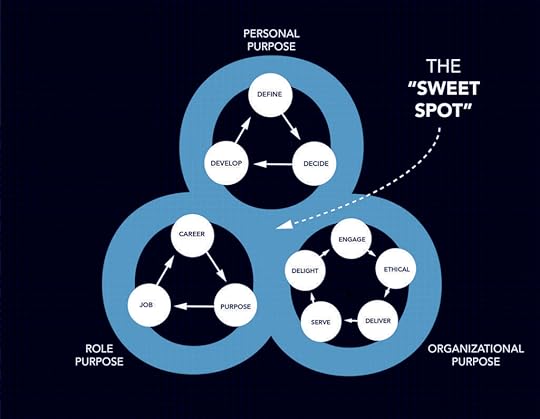
Consolidation and/or Recapitulation Process: How will I bring all the important ideas from the learning experiences together for/with the students? How will I check for understanding?
1) Put students into groups of 3-4. Have them think of a business they want to start in adulthood. Ask them to define how that business is going to operate. Ask them to define a “purpose statement” for their business.
2) Each group shares their 1-3 line purpose statement for the business they have dreamed up. (Note: steer them in the direction of balancing society, versus solely seeking profits, etc.)
3) Ask the class to decide what group has the best “purpose statement.” Why would you buy their product/service versus the others? (Push for the behaviours/attributes that were outlined earlier.)
Application: What will learners do to demonstrate their learning? (Moving from guided, scaffolded practice, and gradual release of responsibility.)
1) Give students time to create their own personal purpose statement. What is it they want to be, in terms of their what, who and how? Use the following guideline:
a. Develop. What is the student going to do to grow and establish their personal values, priorities and attributes? Students who successfully and continuously develop, answer the question: What am I doing to evolve my self?
b. Define. Who is the individual trying to become in life? Students who successfully define, answer the question: Who am I in life and at work?
c. Decide. How will the individual operate when balancing the realities of life with the opportunity for growth? Students who successfully decide, answer the question: How will I operate and be perceived by others?
2) Ask those that want to share, to share their personal purpose statement with the class.
7. CONCLUSION: How will I conclude the lesson?
Read the following:
Desiderata
Go placidly amid the noise and haste, and remember what peace there may be in silence. As far as possible without surrender be on good terms with all persons. Speak your truth quietly and clearly; and listen to others, even the dull and ignorant; they too have their story. Avoid loud and aggressive persons, they are vexations to the spirit. If you compare yourself with others, you may become vain and bitter; for always there will be greater and lesser persons than yourself.
Enjoy your achievements as well as your plans. Keep interested in your career, however humble; it is a real possession in the changing fortunes of time. Exercise caution in your business affairs; for the world is full of trickery. But let this not blind you to what virtue there is; many persons strive for high ideals; and everywhere life is full of heroism.
Be yourself. Especially, do not feign affection. Neither be critical about love; for in the face of all aridity and disenchantment it is as perennial as the grass.
Take kindly the counsel of the years, gracefully surrendering the things of youth. Nurture strength of spirit to shield you in sudden misfortune. But do not distress yourself with imaginings. Many fears are born of fatigue and loneliness. Beyond a wholesome discipline, be gentle with yourself.
You are a child of the universe, no less than the trees and the stars; you have a right to be here. And whether or not it is clear to you, no doubt the universe is unfolding as it should.
Therefore be at peace with God, whatever you conceive Him to be, and whatever your labors and aspirations, in the noisy confusion of life keep peace with your soul. With all its sham, drudgery and broken dreams, it is still a beautiful world. Be careful. Strive to be happy.
© Max Ehrmann 1927
8. My Reflections on the Lesson
What do I need to do to become more effective as a teacher in supporting student learning?
All of us are marching toward our own path to the waterfall. Death befalls us all. How we treat one another—how we engage with society—is what ultimately defines us. Purpose trumps hate on that path, for all of us.
Note: Cross-posted to The Huffington Post.
Dan's Related Posts:The Critical Importance Of Defining Your PurposeCool Contest: Win 1 of 10 Free Copies of The Purpose EffectDownload Chapter 1 of “The Purpose Effect” For FreeCan Humanism Replace Capitalism?Conation: The Word of 2015
November 8, 2016
The Eye Chart Analogy Of Corporate Org Charts
If you look at this graphic I mashed up long enough, it begins to make sense.
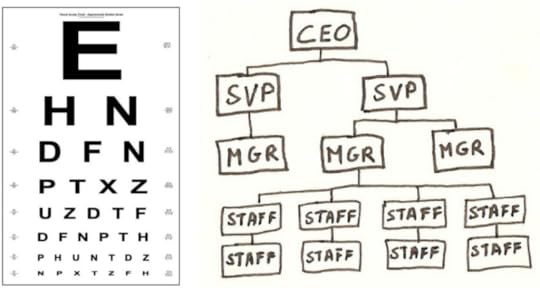
If you’ve ever been to see an ophthalmologist or optometrist and had an eye test, chances are you were asked to view a diagram like the one above on the left. You close one eye, and the doctor asks you to read out the letters one line at a time. The process repeats with the other eye.
The problem is–if you have issues seeing things far away like me–as you venture down the chart, you begin to have difficulty reading out the letters. Dependent on your vision, you may not even recognize the final row of letters. It may even be lines of letters before the final row. According to the Vision Council of America, 75 percent of adults use some sort of vision correction like glasses, contacts or corrective surgery.
It donned on me that this is a significant and parallel issue with leadership.
Senior leaders can easily make out the letters at the top of an organizational chart. These are the people they come into contact with somewhat regularly if not daily.
But what about those employees way down the eye chart? Do leaders see them? Do they even make an attempt to sort out what/who they are?
If a leader discounts that there are letters toward the bottom of the eye chart, no doubt it will become a recipe for employee disengagement.
My advice?
Don’t treat your org chart like an eye chart.
Get corrective surgery, glasses or contact lenses if you can’t see those that are on the far rungs of the corporate ladder.
Everyone in the organization deserves 20/20 vision.
Dan's Related Posts:The Connected CultureIs Your Corporate Culture The Root Cause Of Bad Meetings?What I Learned About The Stigma Of My StigmaIs George Siemens Right? Social Media is like Letters to the EditorIn Answer To Your Questions About FLAT ARMY
October 28, 2016
That Laugh
Not so much a cackle but a chortle
Gleefully bellowing like a bird in spring.
It was welcoming and free
That laugh.
Did your beguiling smile arrive before or after?
Maybe it was there before and after.
Whatever the season, your twinkle was emboldened by
That laugh.
Dabbers and beer, fiddles and song.
Small talk wrapped in bouquets of love.
Words so often impregnated by a French drawl.
That laugh.
Ce que tout le monde dit doit être vrai.
Chacun à son goût.
Eternity and beyond, the glow carries.
Forever, that laugh.
Dan's Related Posts:We May Not AlwaysIn 2015, Will I …In 2014, I Will …O Canada My CanadaFor every fall there is a spring in our step
October 15, 2016
Metaphors on Mission
Metaphors on Mission
Imagine a soul ruled by dictators of power and division,
A soul steeped in blissful harmony yet averse to absolutists,
A soul which acknowledges the reality of both crest and trough
But which lives life in dominion’s shadow,
Urging others toward a higher ideal.
You have it in you, such soul.
How many people sit atop the pit of doom afraid to jump across?
How many refract the light to distort Veritas?
How mindful are they to blatant myopia and bias?
Do you have it in you, sole?
Imagine a world spilling over with meaning and flourishing with boundless warmth and open hearts.
Imagine a world filled with such souls on a mission to defeat the despot and unearth the light.
“Onward, daily, forward, away.”
Imagine a world where “purpose was the word.”
Yes, soul, imagine a world where “purpose was the word.”
Dan's Related Posts:In Victim“The Inevitability of Death”The Electrocardiogram of PurposeA New Hero of Mine, Alfredo MoserAutotelic: The Word of 2013
October 3, 2016
How To Build A Truly Purpose-Driven Company Through The Example Of Stocksy
You are undoubtedly familiar with so-called “sharing economy” titans such as Uber and AirBnB. The latter is an online marketplace for people to list and/or book accommodations. It might be a room, a home or a castle. AirBnB is a prime example of disruption in the hotel industry. They market other people’s dwellings and then take a percentage of the revenue from the transaction. It claims to have 50,000 renters every night. That’s 50,000 people not renting a hotel room.
On the transportation side of things, Uber connects consumers through an app with independent drivers who own their own vehicle. Taxis are no longer a consideration for many people. In fact, the company celebrated its 2 billionth Uber ride this past July.
Whichever way you slice it, both companies are wreaking havoc on existing business models.
But there is a problem. These are not truly “sharing economy” companies. For the record, I’m with Harvard Business Review authors Giana M. Eckhardt and Fleura Bardhi who made a strong case against using the term “sharing economy” when it comes to firms like Uber and AirBnB. The authors suggested these sorts of businesses—where products and services are traded on the basis of access rather than ownership, when trade is done temporarily and not permanently—ought to be referred to as the “access economy.”
Eckardt and Bardhi write:
“A successful business model in the access economy will not be based on community, however, as a sharing orientation does not accurately depict the benefits consumers hope to receive. When “sharing” is market-mediated — when a company is an intermediary between consumers who don’t know each other — it is no longer sharing at all. It is an economic exchange, and consumers are after utilitarian, rather than social, value.”
While there isn’t anything fundamentally wrong with companies like Uber or Airbnb in the “access economy”, they are not examples of organizations who are truly “sharing” nor are they reinvesting any of its revenues or profits into the workers and/or materials it rents. It extracts money from its “partners” and reinvests the profit in itself, not those who are its labourers. .
Which brings me to Stocksy and the business model of a “Platform Cooperative.”

In its simplest form, a Platform Cooperative is defined as “worker–owned cooperatives designing their own apps-based platforms, fostering truly peer-to-peer ways of providing services and things”.
Put differently, those doing the work are owners and are both compensated for such effort and regarded as members of the greater team. A Platform Cooperative is not in it to extract money from its labourers through the rental of talent, service or even capital. Its business model is not about renting access.
Stocksy is an exceptional example to delve deeper into the notion of being a Platform Cooperative. Headquartered in Victoria, British Columbia, Stocksy is the online home to a highly curated collection of royalty-free stock photography and video footage that is “beautiful, distinctive, and highly usable.” What I love about Stocksy is that it is in business for all of its stakeholders, not just the owners, founders and senior leadership team. Its motto, “We believe in creative integrity, fair profit sharing, and co-ownership, with every voice being heard,” found on its About Us webpage is a tribute to the operating ethos of any Platform Cooperative.
I stumbled across Stocksy one day in June of 2016 courtesy my Twitter feed. I had never heard of the company prior to that serendipitous tweet. After a few clicks, I realized they were in fact headquartered in Victoria. “Oh my,” I said to myself. “I live in Victoria! I have to go find these people and understand more.”
The tweet I tripped over was from VIATEC—a group that represents Vancouver Island’s advanced-technology community—announcing its Executive of the Year, Stocksy CEO and co-founder Brianna Wettlaufer. “Brianna brings a unique combination of high expectations and encouraging support,” said Dan Gunn, CEO of VIATEC, after I asked him about Brianna. “Add to that her sophisticated sense for culture trends and aesthetics along with her savvy as a business woman and you get a very rare type of leader.”
I reached out to Brianna myself, and she agreed to meet with me over a latte. (How very West Coast.) She also brought along Nuno Silva, Stocksy’s vice-president of product.
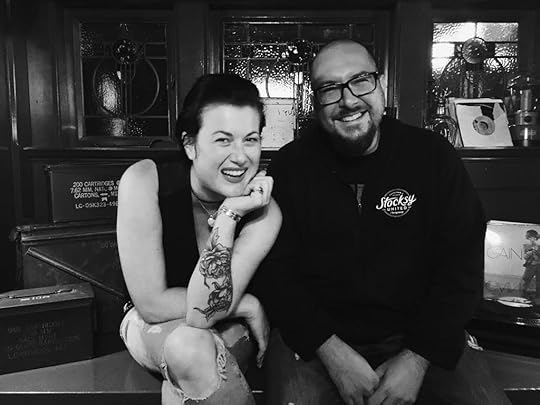
The first thing I had to ask about was related to Stocksy’s motto. Why is it important for Stocksy to demonstrate “creative integrity, fair profit sharing, and co-ownership, with every voice being heard?” As an artist, Brianna believes it is highly unethical to approach business from any other angle than transparency and accountability while continuously rallying to support and inspire the creators—the workers. “When you use this approach,” she said, “you’re investing in the long term success, integrity, and people working for the product, so you shouldn’t have to make choices that are intentionally designed for short term gain at a huge cost.”
Nuno indicated honesty, integrity, fairness and giving back were all driving reasons for starting Stocksy in the first place. “Given our collective experience in the industry as business professionals and contributing artists and photographers,” Nuno added, “it led to a holistic perspective of representing every angle in an ethical approach that lived up to those values.”
Stocksy defines its business model as follows:
“An online community business designed to put power back into the hands of its co-owners through collaboration, fair distribution of profits, and ethical business practices.”
This is of course highly unusual in terms of business models, but not to Brianna or Nuno. In fact, one may argue that their leadership style is rather antithetical to today’s business leaders.
“I’m fortunate in having always worked for start-ups, where you’re forced to wear a lot of hats and commit to the gritty work, no matter what it takes, to make a company survive,” said Brianna. “This always made business a passionate pursuit, leaving me confused why “business” had to be a dirty word. From my experience, the value of doing something you love, that supports an amazing community creatively and financially, with the added joy of creating an integrity-driven product, is much more motivating and rewarding than chasing wealth.”
But Stocksy is a business. It needs revenue (and profits) to survive and ultimately to grow. How does it remain true to its purpose—as a Platform Cooperative—aiming to serve everyone that is part of the collective?
“By focusing on sustainable growth, even at the sacrifice of a quick gain,” replied Nuno rather matter-of-factly. “The co-op model reflects this. It’s designed to create checks and balances in everything we do so that we can’t do anything that isn’t in our community’s best interest, or without complete transparency.” Becoming more passionate as he continued his train of thought, Nuno said, “It requires more work, but it’s a challenge we welcome in our commitment to community and our stakeholders.”
In 2015, Stocksy earned $7.9 million in sales—doubling its revenues from the year prior—and it paid out its first ever dividend of $200,000 to its members. This was in addition to the money artists were paid for selling their images and videos in the first place, a whopping $4,323,735.
But where will Stocksy be in 5-10 years? Aside from supporting photographers, community and creative integrity, Brianna is “naively stubborn enough,” as she puts it, to advocate that the Stocksy model of Platform Cooperatives could help turn traditional business on its head. “Business can be fun,” she said, “and it can be driven by creativity and purpose.”
Dan Gunn agrees. Asked about the future of Stocksy, he said, “The world is largely deprived of authenticity and anything that puts quality and inspirational values at its core has a good chance of generating a following. When you add their experienced leadership team you have almost a sure thing.”
Brianna’s ultimate wish? “To keep waking up every day, respecting each other, just as inspired as the next to keep creating an amazing product while benefiting the many, building trust and empowering workers and staff.”
On platform cooperatives, The New School associate professor, Trebor Scholz writes:
“[Platform Cooperatives] can be a reminder that work can be dignified rather than diminishing for the human experience. Cooperatives are not a panacea for all the wrongs of platform capitalism but they could help to weave some ethical threads into the fabric of 21st century work.”
I could not agree more. Stocksy sheds a shining Victoria Inner Harbour light on this wonderful, purpose-driven movement of Platform Cooperatives.
Maybe it is time for both Uber and AirBnB to contemplate becoming a Platform Cooperative, too.
Dan's Related Posts:A Few Easy Steps For Entrepreneurs To Take To Enact A Higher PurposeThe Collateral Damage of Selfish LeadershipDear Mr. Pontefract – I Need a Connected Learning Platform5 Use Cases for a Corporate YouTube in OrganizationsTo The Establishment
October 2, 2016
650,000 Words Later
A rough count of the number of words I have written and made publicly available since 2007 sits at ~650,000 words … between books, articles, posts and essays.
 CC Dan Allison
CC Dan AllisonWow.
I had not thought to count them before.
Sometimes I wonder if those words are actually making a difference. Are they even supposed to make a difference?
Some argue writers ought to write for themselves. I’m not sure if I agree with that. I write so I can learn–trying to become a better autodidact during the writing process–but on the other hand, I *publish* what I write to hopefully help others.
If I don’t publish the words I am merely learning. If I am not sharing the words I am solely an autodidact. But when I publish I become both an autodidact and a teacher.
Maybe that’s the key.
The question is, am I a good enough autodidact to be a worthy teacher?
Maybe that’s a question for all of us. Are we both an autodidact and a teacher?
Can I become a better writer, teacher and thus autodidact?
I hope I can write another 650,000 words.
Dan's Related Posts:Gord Downie May Be The Best High School Teacher I Never HadLessons Learned From a First Time AuthorI Wrote a 90,000 Word Book Entirely in EvernoteAnnouncing the Full Book Cover Jacket of Flat ArmyI’m Showing My Work … My Next Book Is Postponed
September 29, 2016
The Blackberry Verdict Is Not Surprising
 In 2013, I wrote a book titled “FLAT ARMY: Creating a Connected and Engaged Organization.” I recently hummed and hawed about whether I should update it with a second version, or write my third original book. I chose the latter but recent news that Blackberry will no longer be manufacturing mobile phones led me to think about what I wrote about the company in Flat Army.
In 2013, I wrote a book titled “FLAT ARMY: Creating a Connected and Engaged Organization.” I recently hummed and hawed about whether I should update it with a second version, or write my third original book. I chose the latter but recent news that Blackberry will no longer be manufacturing mobile phones led me to think about what I wrote about the company in Flat Army.
I thought I would share those words below in their entirety. (Of course, back then the company was still called Research in Motion or RIM for short.)
My last line includes “only time will tell.” Well, time has told us the company has made blunder upon blunder. If it does manage to turn it around–operating solely as a software maker versus a software and hardware maker, entering into a licensing agreement with an Indonesian company to make and distribute Blackberry branded devices–it will be incredibly ironic that the company that switched its name from Research in Motion to Blackberry will no longer be designing and manufacturing the device it changed its name to.
From Flat Army:
Which brings us to another example, this one dealing with Research in Motion, more commonly known as RIM — makers of the iconic Blackberry smartphone. Pundits from San Francisco to Siberia to Sydney have written off this Canadian company since 2008. Many claim RIM is no longer relevant in an Apple, Google, Samsung and Microsoft dominated smartphone ecosystem. According to Canaccord Genuity Estimates, RIM’s global market share dropped from 19.7 per cent in 2009 to 10.8 per cent by the end of 2011. It further predicted a market share drop to 6.1 per cent by the end of 2012 and 4.9 per cent by the end of 2013. Whether you’re a shareholder, a customer, an executive or an employee, those numbers are difficult to digest. Gloomy is one word that comes to mind. What happened?
Kara Swisher is co-executive editor of the popular Silicon Valley based media organization AllThingsD and has been outspoken about RIM on several occasions. In September of 2012, for example, while speaking at a Women in Film and Television event, she stated the following:
“RIM is a perfect example of failing to respond to consumer changes. Lazaridis is a genius. But RIM missed so many consumer trends because they were protecting an old business. In the end, they broke their consumer relationship by not innovating.”
The ‘Lazaridis’ she refers to was ex co-CEO Mike Lazaridis who, alongside fellow co-CEO Jim Balisillie, helped bring RIM to the forefront of innovation and success only to see it — and their roles as co-CEO — vanish before their eyes. Through a 20-year span, it could be argued both men helped launch the smartphone industry itself. Blindsided by the success of the Apple iPhone however — which launched in 2007 — it could be argued Lazaridis and Balsillie were the reason for both RIM’s success and its recent collapse. They knew what worked up until the height of RIM’s dominance, but rather than adjusting and having the foresight to alter course, they remained shackled to what worked from their past. In doing so, their stock price went from roughly $140 to $7 in a four-year period. Gulp.
Rather than being rigid and inflexible and incapable of change, what if the elements of Flat Army had been employed at the company many moons prior? Would it have made a difference? There is reason to suggest RIM was a company of command and control habits. There is reason to suggest Lazaridis and Balsillie didn’t listen to or involve their employees. For this type of closed-minded behaviour the company is dearly paying a price. Could Flat Army save it still?
By way of example, in the summer of 2011 an anonymous letter from a high ranking RIM executive was sent to Jonathan S. Geller, founder of the popular mobile and telecommunications website BGR. Geller verified the source and proceed to publish the letter to the site. The letter starts out as follows: (accessed August 31, 2012. )
To the RIM Senior Management Team:
I have lost confidence.
While I hide it at work, my passion has been sapped. I know I am not alone — the sentiment is widespread and it includes people within your own teams.
With confidence and passion lacking not only with this leader but alleged to be widespread, it really comes back to our thesis in Chapter 1; this employee has become disengaged and if it’s afflicting others, there is no doubt the company could be in for future worrisome troubles.
The letter goes on to state:
Reach out to all employees asking them on how we can make RIM better. Encourage input from ground-level teams—without repercussions—to seek out honest feedback and really absorb it. We should also address issues surrounding making RIM an enjoyable workplace. Some of our offices feel like Soviet-era government workplaces.
Does this sound to you like the makings of a Flat Army organization or is its leadership team in a state of denial?
Dr. Marc Weber of the University of Waterloo — which coincidentally is in RIM’s backyard — asserts that given the choice between individualism and the situation, people will naturally gravitate toward the situation rather than their own individuality. In other words, if the behaviors of an organization are, for example like RIM — hierarchical, rigid, closed, non-collaborative and uncooperative — even if an individual employs the opposite of these traits at a personal level and from the onset of their arrival — the employee will, over time, act more like the organization (the situation) than how they might have behaved prior to joining the organization.
What was the situation at RIM? It was an organization whose leadership and leadership behaviours were closed and unrepentant. There was no evidence of collaboration once the Apple iPhone arrived on the scene. Communication channels seemed to be non-existent between staff and senior management. The situation at RIM was one of ego, bravado and ruthless ignorance. The situation was a giant example of groupthink. To many RIM seemed to morph from an innovative and flexible organization to one that was rigid, blind and hierarchical. The situation at RIM was ignorance and many of its leaders were culpable. The situation has become a vortex with close minded behaviour at the root. It has landed the organization in the deepest of all crises leading to the reduction of its workforce by over 5,000 employees and operating expenditure by over $1 billion in 2012 alone.
There are some interesting developments at RIM though. Firstly, Lazaradis and Balsillie heeded the calls to resign and did so in early 2012. Thorsten Heins — RIM’s COO at the time — took the reins and has been leading the charge to turn around the company and its future outlook. In the summer of 2012, Heins wrote an editorial in The Globe & Mail where he stated:
“RIM has chosen to pursue a strategy that eschews the homogenized sameness of competing ecosystems. To help with that task, we have reshaped the executive team and recruited telecommunications industry veterans with proven track records of success.”
I found it compelling if not confirming that the leadership of the organization had to be both ‘reshaped’ and ‘recruited’. This says to me Heins is in the midst of reshaping and recruiting a culture that is potentially diametrically opposed to the situation that used to envelope the organization. It seems as though the situation is in need of a change. Perhaps Heins is in fact about to deploy Flat Army concepts such that RIM can pull off a similar turnaround like that of IBM, Apple or Ford — the stuff of corporate change legendary lore. With new devices set to launch in early 2013, only time will tell.
Dan's Related Posts:Lessons in Leadership From Jim Balsillie and Mike LazaridisSteer Clear of Organizational Leadership TurbulenceIn Answer To Your Questions About FLAT ARMYThat Decision Is Above My Pay-GradeTaylor Swift and Apple Demonstrate How You Work Things Out In The Open
September 26, 2016
Greenwashing Your Way To Employee Disengagement
The term whitewashing is defined as “a coordinated attempt to hide unpleasant facts, especially in a political context.” It’s easy to see the relationship between it and another less familiar term, greenwashing.
 Greenwashing can be loosely defined as the times in which an organization falsely conveys to consumers that their products, service, or operating practices are socially and/or environmentally responsible.
Greenwashing can be loosely defined as the times in which an organization falsely conveys to consumers that their products, service, or operating practices are socially and/or environmentally responsible.
The recently crowned king of greenwashing is arguably Volkswagen. As it was promoting and marketing its newly designed diesel vehicles as a low-emissions saviour, engineers and senior leaders at the German automaker knowingly tried to hide the fact it had rigged 11 million of those purported environmentally friendly vehicles with fancy software that evaded emissions tests, permitting the vehicles to produce far more pollutants than legally allowed.
Among several lawsuits and government penalties, just this week over 1,400 additional lawsuits had been issued by investors who are seeking $9.1-billion (U.S.) in damages claims. It is fair to say greenwashing has cost Volkswagen billions of dollars.
But Volkswagen is not alone. Coca-Cola,, for example, has run afoul in recent months with the launch of Coca-Cola Life in various countries. Sold in a green can or a recyclable bottle, critics claim the 68 calorie per serving soft drink–with 17 grams of sugar–is another example of tricking the consumer under the guise of a healthy product. University of Sydney nutritionist Dr Kieron Rooney told Daily Mail Australia that, “Coke Life should not be considered a healthy option… it should not even have a seat at the table.”
Volkswagen and Coca-Cola, like any organization, are made up of employees. The question an executive or senior leaders ought to contemplate is at what cost does greenwashing impact things such as employee engagement levels, retention, commitment, attraction or customer service.
A new study from several researchers looks at what happens when employees view an organization’s efforts related to corporate social responsibility (CSR). The researchers argued company efforts can be classified as either substantive or symbolic.
Substantive can be thought of as CSR efforts that are genuinely aimed at supporting the common good. Symbolic is self-serving and performed primarily by the company for reputation improvement and to enhance profits. One might argue that Volkswagen and Coca-Cola are demonstrating symbolic corporate social responsibility with their respective product launches outlined above.
The researchers used three samples of data, and aggregated more than 1000 working adults. They then developed and tested for substantive and symbolic corporate social responsibility. They found:
The measure indicated that when employees attribute corporate social responsibility as substantive, benefits accrue to the individual and to the organization as a whole; however, when viewed as engaging in greenwashing, self-serving engagement in corporate social responsibility backfires: employee reactions are negative, and they may do less for the organization and label it as a “taker” rather than a “giver..”
Imagine how employees across Volkswagen are feeling these days. Are they committed to the company? Do they say nice things about their place of work in social settings, like a barbecue or football match? Do you think they are coining the company a taker or a giver?
Dr. Magda Donia, Assistant Professor at the University of Ottawa’s Telfer School of Management and lead author of the research said, “We already knew that a company’s corporate social responsibility engagement produces positive outcomes. Now however, we see that a company jumping on the corporate social responsibility bandwagon just for show or greenwashing doesn’t fool its employees.”
If I were Volkswagen–possibly even Coca-Cola–I would be very concerned.
“A company perceived as disingenuous undermines its own effort,” she continued. “When it comes to corporate social responsibility, the focus should be on the giving, not the getting. The best way to win is to truly give and let visibility and marketability follow.”
Demonstrating worthy corporate social responsibility is an important aspect of an organization’s higher purpose. It’s also an important part of creating a more engaged organization.
But greenwashing is fast becoming as deleterious to an organization’s existence as Frederick Taylor’s stopwatch practices, a management technique that still remains in many call centres and manufacturing lines.
Is your organization greenwashing and/or demonstrating symbolic corporate social responsibility?
Dan's Related Posts:A Lesson On Balancing Purpose With ProfitDocking Employee Pay to Improve Their Skills is Dubious if not DumbThe Social C-SuiteEvolution of the Chief Learning OfficerThe Volkswagen Commercial That Depicts a Backwards Workplace
September 22, 2016
Wow, Did I Ever Fail On This One. But I Learned A Lot, Too.
 As I was preparing to write this column, I looked up the word “fail.” To my surprise, the web version of Oxford Dictionary has a top 1,000-word feature. The word “fail” is firmly nested in its list of top 1,000 frequently used words. Thankfully, the word “success” is on that list as well.
As I was preparing to write this column, I looked up the word “fail.” To my surprise, the web version of Oxford Dictionary has a top 1,000-word feature. The word “fail” is firmly nested in its list of top 1,000 frequently used words. Thankfully, the word “success” is on that list as well.
Why do many of us tend to run from the room screaming when we hear the word “fail”? According to Oxford, we use the word fairly frequently but we seem to be as comfortable with failure as we might be with a spider in our tent. Is it because we were driven into a state of anxiety during our adolescence, frightened by the omnipresent fear of a failing grade from one of our teachers?
I admit, I don’t feel the same way about failure as I do when I’m surfing the warm waters of Australia. But I’m not afraid of failing. Just like I’m not afraid of sharks in those wavy beaches Down Under, I’m not afraid of drowning either.
You have to at least try, otherwise you will never know if you’re succeeding or failing.
Before I entered the corporate world in 2002, I spent roughly five years in higher education. The team and department I was a part of was referred to as “cost recovery.” In short, there were no public funds. For the team and department to remain operating, it survived through the tuition fees of students.
There were four programs we started out with in 1998. One consisted of a six-month, full-time technology support curriculum targeted at people interested in call center careers or tech support. A second program was part time, offered at night and geared toward those looking to improve their skills in the network administration arena. The third program focused on various software development languages, run full-time over six months. A fourth program—12 months in length, full time, and incredibly difficult—was aimed at individuals already in possession of a bachelor’s degree (or higher) who were looking to become business leaders in the high-tech networking, administration, or consulting space.
It’s this latter program, called ITP (information technology professional), where my story of failure and lessons learned begins.
Dive In
Fast forward to 2001. It had been roughly three years since ITP first launched. Each year saw three different cohorts of 30 students commence their studies. Those students were paying a hefty tuition fee as well. For their year of immersive and intense education, each student coughed up approximately $20,000. The program was a mix of leadership development and concentrated technology education. The technology learning focused on concepts such as local and wide area networking, web commerce, and business intelligence amid other technical topics. It did not delve into software development, although baseline web development was taught. The aim was not to make the graduates coders or programmers.
Not all graduates were thrilled with the final result, but the majority of them were satisfied, ultimately landing roles as consultants, analysts, administrators, and so on. After three years of the ITP program, my mind began to wander. I thought it was time to get on another surfboard and test some new bodies of water.
I mused to the team: “What if we took the general concept of ITP—12 months, simulated business model, combination of technical and leadership development, three-month work term, highly interactive, and intensive education experience—and substituted the technology component with web development?”
Because we had an existing education blueprint with the ITP program, I figured it would be a cinch to replicate the success we were having with the existing program simply by replacing one technology stream with another. Instead of networking we’d teach web development. We could keep all key facets of the program intact and everything would be fine. We even had on-site facilities into which the new version of the program could expand. It was going to be so easy you could sense students smiling from ear to ear on graduation day a year later.
I couldn’t have been more wrong. It was a catastrophe. The new program we launched was a failure, but I learned a lot through the process.
Muddy Waters
The first cohort of what we coined PWD—professional web developer program—was small in comparison to ITP (only 18 students versus 30), proving even in the latter part of the dot-com days that not everyone thought web development was going to be an easy ticket to prosperity. Suffice to say, in the lead-up to launching the program, it was an extremely difficult time trying to convince potential students of the merits of PWD. At best, the program was teetering on a small loss.
Next was the curriculum itself. While in theory and on paper, it made sense to swap out one type of technology education for another, it was a critical error. Network administration is much different from web development, yet we were accepting the same types of students as in ITP. So long as you had a degree, we felt we could teach anyone to code. It was a colossal mistake.
Problems popped up the very first week. Some of the students were doing very well, while others were experiencing incredible difficulties with the prospect of learning how to code. The gap in skill was a detriment to the other aspects of the program (leadership development, business simulation, etc.) because more time than planned had to be spent on the technical education.
Finding paid co-op placements also was a nightmare. In the ITP program, almost all positions for the three-month work-term period were paid. As we rolled out the PWD program, less than a handful were paid. As you can imagine, the level of stress was extremely high—to the point of several students demanding partial refunds on their tuition when graduation day rolled around.
Learning Moments
You have to try. Even though it was not the result I was hoping for, there were three classes that went through the program who then embarked on careers in the web development space. Had we not tried as a school, would those individuals ever had made the career change? I learned to always try even against the odds.
Blind faith is not enough. Even though four programs were running successfully, previous success does not guarantee future success. Just because you’ve had previous success does not mean you should be blind to potential pitfalls or ignorant to your own confirmation bias. I learned to play devil’s advocate against my own ideas.
Groupthink is actually a thing. Although I was the instigator of the program, everyone went along with the plan. There was not a truly critical debate on whether it was a good idea or a bad idea to launch the program. I learned we ought to have sought external opinion and market analysis on the merits of the program.
The ole switcheroo is fool’s gold. Naively thinking that swapping one technology education stream for another without there being downstream ramifications was evidence of either belief bias or optimism bias on my part. I learned never to assume one product type will work for another situation.
Failure is an option. George Bernard Shaw once wrote, “A life spent making mistakes is not only more honorable, but more useful than a life spent doing nothing.” I’ll take trying something over doing nothing every day. In fact, that’s how I learn.
Dan's Related Posts:Whose Your Brian Reid?Dear Mr. Pontefract – I Need a Connected Learning PlatformWould You Send Your 6-Year Old to an MBA Program?What I Learned From My Daughter About Decision MakingABC – The 21st Century Learning Model
September 19, 2016
Nine Tricky Questions And Nine Honest Answers Regarding Purpose
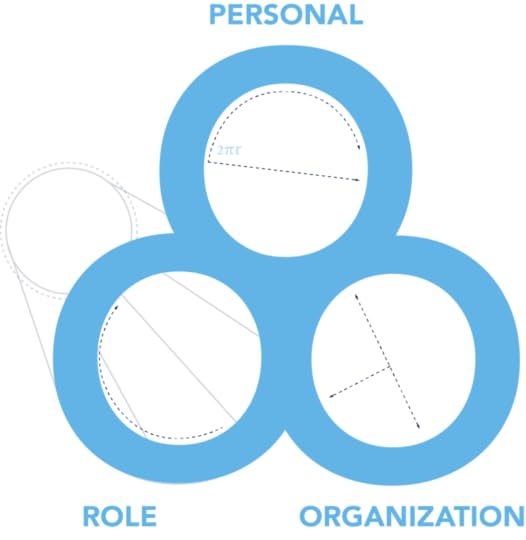 A reader took the time to read “The Purpose Effect” and then asked me a few questions. I answered those questions, and have decided to post the responses in this space.
A reader took the time to read “The Purpose Effect” and then asked me a few questions. I answered those questions, and have decided to post the responses in this space.
Q: Do you think “any” individual is capable of reaching the sweet spot – or is it only for the courageous, determined, hard-working and persistent of us?
Dan: I remain an optimist, so yes, the ‘sweet spot’ is open to all, and a viable option to anyone who wants it. But that’s the key. I believe there are some uninterested in the sweet spot. They are perfectly content to ‘mail it in’ or treat the role as a ‘remuneration transaction.’ Perhaps it’s a different definition of the ‘sweet spot.’ Perhaps it’s the ‘ambivalent spot.’
Q: What role does “character” and “personal circumstance” play in shaping that ability to find your personal purpose and meet with role and organisational purpose?
Dan: Each of us possesses ‘character’ and ‘personal circumstance.’ Each of us has the ability to develop what we like/dislike, who we want to be (now and in the future) and how we are going to show up each and every day, regardless of where we do it. Purpose is not cordoned off to those with more money, assets, networks, lineage or perceived positivity in life. If people self-assess to a false conclusion that their situation or character is undeserved of purpose in life (or work) they are as naïve as Gimpel the Fool.
Q: Does serendipity ever play a part in defining your personal purpose or role purpose?
Dan: I’m not sure serendipity plays a big part in defining your personal purpose (that actually takes some effort) but it sure can come into play with the overall ‘sweet spot’ equation. There are many people who have the good fortune (perhaps, we can call it happenstance) of entering into a profession, or a role or an organization where everything just seems to click. For example, there are very few realtors who set out to become realtors in their teens. Somehow, they are introduced to the profession—often by a friend or the experience of real estate itself—and it dons on them that this might make a great career. A friend of mine was an account executive in high-tech for about six years. She was miserable. Only until she went to sell her own home, did she realize how much she loved prepping the home, learning about the local real estate industry, and finding a new home. She took a realtor course, and has been loving her role, self and organization for the past eight years.
Q: How “effective” is it for an individual to achieve the “sweet spot” between organisational, role and personal purpose – if the colleagues around them have not? Could it then become an existence in a sweet spot “island”?
Dan: I have found that the ‘sweet spot’ (at least in terms of one’s role and the organization) is at times tied to employee engagement. If a team is engaged, there is a higher likelihood for the sweet spot to materialize. If the team is miserable—thus team members are disengaged or disenfranchised—due to inane leadership, absurd organizational practices/policies or poor business processes, the chance for the sweet spot rapidly diminishes. But there are anomalies of course. Many airlines, for example, have low engagement scores particularly of flight attendants. But everyone can recall that flight attendant who goes the extra mile (no pun intended), serving up smiles and cheer alongside the tea and biscuits. They clearly love what they’re doing, in spite of difficulties within the organization and team members.
Q: You connect the dots between personal, organisational and role purpose – but does it then connect the dots between the “large swathes of team members” that you speak about? Are you assuming that organisational purpose will drive those connections?
Dan: If an individual aligns their personal purpose with the organization’s defined purpose, there is indeed a greater likelihood that organizational purpose will help others drive those connections. Take for instance NASA. It has one of the highest engagement scores across any public sector organization in America. Its organizational purpose is crystal clear, and it is ultimately helping to attract, retain and develop employees with a purpose mindset in their roles while at work. Its purpose is to “reach for new heights and reveal the unknown for the benefit of humankind.” If an organization is confused with its purpose (whether fixated on profit, power, etc.) employees misaligned will find it hard to connect, both to the purpose of the organization and each other.
Q: Would you not say that the ultimate beneficiary for a for-profit organisation of their employees finding the sweet spot – is the organisation itself, irrespective of the benefits the employee may feel personally or in their roles?
Dan: If an organization were myopic enough to think that they are the ultimate recipient and beneficiary of an organization replete with purpose mindset employees, I would have to say that organization has missed the plot entirely of “The Purpose Effect.”
Q: An organisation may not be able to “pay its way to the purpose effect” but do you not think that being remunerated appropriately can enhance an individual’s feeling of self-worth and so help develop that role and personal purpose?
Dan: I completely agree. Appropriate remuneration is a problem in many of today’s organizations. As Jon Husband has taught me over the years, there is an element of professional collusion that has been going on for years between organizations with respect to determining compensation bands. To pour salt on the wound, executive pay has been intricately tied to increases in shareholder return, a theory put forward by Milton Friedman in the early 1970’s. Not surprisingly, since 1974, C-Suite executive pay has risen over 300 percent whereas the average worker has only witnessed a 10 percent increase. (In today’s dollars) Case in point, proxy filings have proven that between 2007 and 2015, pharmaceutical company Mylan saw its CEO Heather Bresch’s compensation increase from $2,453,456 to $18,931,068, a 671 percent increase. How do the workers of Mylan feel about their CEO and her stratospheric pay raise?
Q: You say “Every one of us should be constantly viewing and reviewing both work and life through acts of inspection and introspection” Do you not think this inward way of looking prevents you, rather than helps you, from viewing and reviewing the needs of others around you and from truly understanding the wider picture in which you fit and which you hope to benefit?
Dan: I suppose I don’t take the words ‘inspection’ or ‘introspection’ to connote as inward only thinking. Inspection and introspection—at least to me—is both internal and external, inward and outward facing.
Q: Can your personal and role purpose combine in a place that brings meaning to you and others but does not necessarily align with the purpose of the organisation? Can you “make meaning” whilst the organisation “makes money”?
Dan: Every for-profit organization needs to “make money” in order to grow, survive or to serve the rest of its stakeholders. If someone has an issue with this side of an organization’s mission—the need to make money—they would be wise to consider working for an NGO, public sector or not-for-profit organization. And yes, TOMS shoes, for example, is a perfect example of a company that has to make money, while it continues to make meaning. LSTN and gDiapers are two others examples that I highlight in The Purpose Effect.
Dan's Related Posts:Lo-Tech Talk #4: The Sweet Spot of PurposeDownload Chapter 1 of “The Purpose Effect” For FreeFree Download of Chapter 1 – The Purpose Effect My TEDx Talk on The Purpose EffectThree Tough Questions Answered About Purpose




